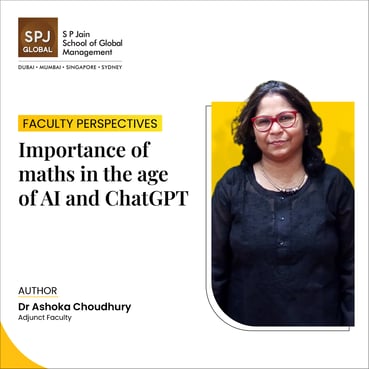Have you ever wondered why maths is the secret sauce of AI? In fact, if AI were a dish, maths would be the secret sauce—the ingredient that brings it all together. Let’s unpack how maths quietly powers AI and why understanding it is key to working with (or just understanding) intelligent systems.

But how? What to read and how much?
At its core, AI is a pattern-finding machine. It looks at massive amounts of data, finds regularities, makes predictions, and improves its accuracy over time. This ability to spot and leverage patterns is something mathematics has been doing for centuries. Whether we’re talking about number sequences, geometric shapes, or trends in data—maths is all about recognising structure and using it to make sense of the world. AI is just the modern face of this ancient mathematical tradition.
How does the AI manage to find patterns?
Linear Algebra – The Language of Data
Most AI systems handle data in the form of vectors and matrices. Whether it’s an image, a piece of text, or a user’s preferences, it's represented mathematically—often as rows and columns of numbers.
Linear Algebra provides the tools to manipulate these data structures. For example: Matrix multiplication helps AI combine inputs and weights in neural networks. Vector operations are used to measure similarities between items (e.g., in recommendation systems). Dimensionality reduction helps simplify complex data for faster processing. Without linear algebra, the internal computations of AI models simply wouldn’t be possible.
Calculus – How do AI models learn
AI systems don’t just sit with fixed rules, they learn. This learning process is powered by calculus, specifically differential calculus, which deals with change. AI models are trained to minimise error using a method called gradient descent. It works like this:
- The model makes a prediction
- The error is calculated
- Calculus helps figure out how much each parameter (or “knob”) should be adjusted to reduce that error
This cycle happens millions of times during training, gradually helping the model improve its accuracy. It’s essentially maths-driven trial and error at lightning speed.
Statistics & Probability: Dealing with Uncertainty
AI often works in the real world, where data is noisy, incomplete, or uncertain. This is where statistics and probability shine.
Probability helps models make predictions, like the likelihood you’ll click on an ad. Statistics helps them make decisions based on data, even when it’s not perfect. Concepts like Bayesian inference, regression, and confidence intervals are fundamental in making AI decisions sound and reliable.
Whether it’s a chatbot interpreting your intent or a model predicting tomorrow’s weather, these tools help AI handle the grey areas of real life.
AI and Maths: A two-way street
What’s exciting is that while maths powers AI, AI is also transforming maths.
AI is now used to:
- Discover new mathematical theorems
- Optimise complex equations in physics and finance
- Simulate systems we couldn’t model before
This feedback loop is pushing both fields into exciting new territories.
AI isn’t magic—it’s maths in motion. Next time you hear about a new breakthrough in AI, remember behind every algorithm, every prediction, and every “aha!” moment, there’s a layer of solid, beautiful mathematics quietly doing the heavy lifting.
AI in data science curriculums
SP Jain School of Global Management's Bachelor of Data Science (BDS) program intricately weaves mathematical foundations into its curriculum, ensuring students are well-equipped to tackle AI-driven challenges in both academic and professional settings. The maths curriculum is crafted so that it progressively deepens students' understanding of essential mathematical concepts. In year 1, courses like Mathematics for Data Scientists, Introduction to Statistics and Probability, Linear Algebra, and Calculus lay a groundwork for analytical thinking and problem-solving. This is followed by complex topics such as Advanced Calculus, Advanced Linear Algebra and Applications, and Algorithms and Data Structures which are pivotal for understanding and developing AI algorithms. The final year of this course focuses on the applications: Simulation Modelling, Data Mining, and Big Data Processing Techniques and Platforms, allowing students to apply mathematical theories to real-world data scenarios.
AI applications by BDS students
In the final year at SP Jain Global, BDS students undertake applied analytics capstone projects designed to provide practical, hands-on experience. The projects involve identifying and interpreting actionable information from raw data, utilising mathematical models to make informed, valid decisions and developing AI-driven solutions to complex problems.
For instance, one of our student projects focused on building an AI model to predict species compatibility for ecosystem restoration, demonstrating the application of AI in environmental conservation. Our students have also interned at companies like Adaptive Investments, contributing to the development and deployment of algorithms using AWS Lambda.
These experiences allow students to apply classroom knowledge to practical problems, and thus gain exposure to AI tools and platforms to enhance their understanding of how mathematical theories underpin AI applications in industry settings.
Through a combination of rigorous academic training and practical experience, SP Jain Global’s BDS program effectively integrates AI into its capstone projects, equipping students with the skills necessary to excel in the evolving field of data science.
About the Author
Dr Ashoka Choudhury is our adjunct faculty, and a few of her noted specialisations are in the areas of Real and Complex Analysis, Linear Algebra and Advanced Calculus. She has earned her doctorate in philosophy focusing on mathematics, mathematical modelling of student learning and mathematics anxiety.

